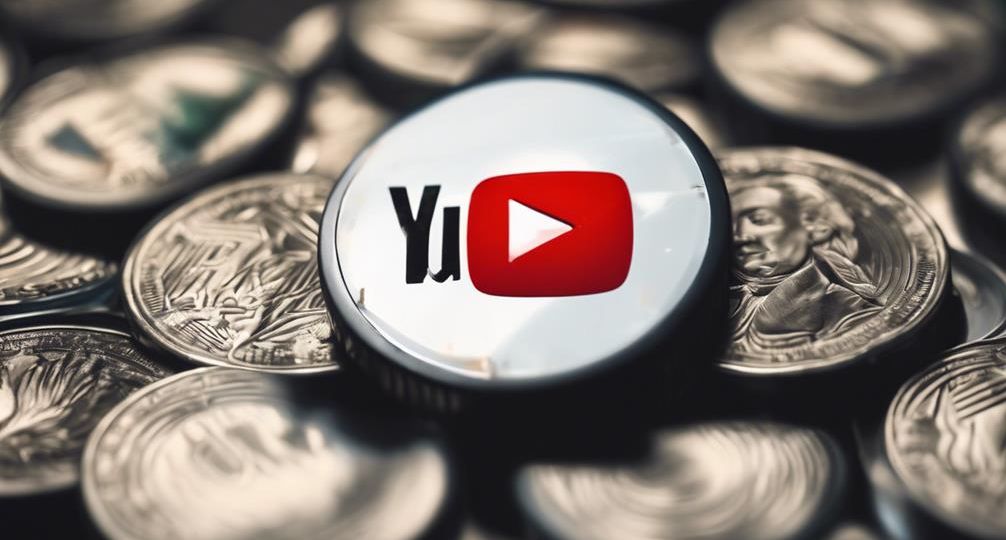
Does YouTube pay $1 per 1000 views?
You’ve heard the claims, you’ve seen the videos, and you’re curious: Does YouTube really pay $1 per 1000 views?
While it’s true that content creators can earn money from YouTube, the exact amount isn’t as straightforward as a simple ratio. Factors such as ad quality, viewer location, and video length all play a role in determining your potential earnings.
So, if you’re considering a career as a YouTuber, don’t be too quick to accept that $1 per 1000 view myth. The reality is much more complex, and arguably, far more intriguing.
Key Takeaways
- YouTube’s payment isn’t based on a flat rate per views but depends on various factors including ad engagement and viewer demographics.
- Unique and high-quality content can attract advertisers which in turn increases potential ad revenue.
- Ad revenue varies based on the type of ad and the audience’s demographics, not just the number of views.
- Maximizing earnings requires strategic content creation, SEO optimization, and audience engagement, not merely accumulating views.
Understanding YouTube Monetization

Often, you may wonder how YouTube monetization works as it’s a crucial aspect for content creators looking to earn from their videos. The process isn’t as straightforward as you might think, it’s a game of strategy involving YouTube’s Monetization Policies and effective Video Optimization.
YouTube’s Monetization Policies are the rules set by the platform governing how creators can earn money from their content. It’s not enough to just upload videos and hope for the best. You must ensure your content adheres to these policies which include, but aren’t limited to, copyright laws, community guidelines, and advertisement-friendly content. Violating these policies can result in monetization suspension or even channel termination.
Video Optimization, on the other hand, is a crucial strategy to increase your chances of earning. It involves creating engaging content, using appropriate titles, tags, and descriptions, and even optimizing your video thumbnail. The more viewer-friendly your video is, the higher the chance that YouTube’s algorithm will recommend it, leading to increased views and potential earnings.
In essence, understanding YouTube monetization involves a blend of policy compliance and strategic content optimization. Mastering these aspects can make a significant difference in your video’s profitability.
YouTube’s Partner Program Explained
Now, let’s move on to understanding YouTube’s Partner Program.
You’ll need to know the eligibility requirements and the application process to become a partner.
Once you’re in, it’s crucial to understand how revenue generation and payment work within the program.
Understanding YouTube’s Partner Program
To fully grasp how YouTube monetizes views, you’ll first need to understand the workings of the YouTube Partner Program. This program allows content creators to share in the ad revenue generated by their videos. Key aspects to understand include the Partner Benefits and Program Restrictions.
| Partner Benefits | Program Restrictions |
|---|---|
| Access to YouTube’s monetization features | Must comply with all of YouTube’s policies and guidelines |
| Eligibility for channel memberships | Restrictions on certain types of content |
| Access to our Creator Support team | Minimum requirements for views and subscribers |
Being part of this program can be profitable but it’s not just about making videos, it’s also about managing and following the rules of the program. Understanding these elements will set the groundwork for appreciating the nuanced ways YouTube pays for views.
Eligibility and Application Process
Building on this understanding of the YouTube Partner Program, it’s crucial you’re familiar with the eligibility criteria and application process to maximize your earning potentials.
The steps involved in this process are:
- Adhere to all of YouTube’s policies and guidelines.
- Live in a country where the Partner Program is available.
- Have more than 1,000 subscribers and 4,000 valid public watch hours in the last 12 months.
- Sign up for AdSense to enable monetization and revenue collection.
- Submit for review after meeting all requirements.
Optimizing your content and focusing on viewer retention can help you meet these criteria faster.
Revenue Generation and Payment
Once you’ve successfully navigated the application process and become a member of YouTube’s Partner Program, it’s time to understand how revenue is generated and how payments work. Your primary revenue streams are ads, video sponsorships, and merchandise sales. Ads can be skippable or non-skippable, and you earn every time a viewer interacts with them or watches them entirely.
Video sponsorships, on the other hand, involve partnering with brands to feature their products or services in your videos. Lastly, merchandise sales allow you to sell your own products directly from your YouTube channel.
Payment is typically received through AdSense, requiring a minimum balance of $100 before you can withdraw. Understanding these revenue streams is key to maximizing your earnings.
Factors Influencing YouTube Revenue
You might wonder why YouTube revenue varies so widely.
Two significant factors are the value advertisers place on your content and the demographic reach of your channel.
Let’s explore how these elements can impact your earnings.
Advertiser Value Impact
It’s crucial to understand that the revenue YouTube generates from your views is heavily influenced by the value advertisers place on your content. This value is rooted in ad revenue dynamics and viewer engagement influence.
- Advertisers are more likely to spend on ads that engage viewers effectively.
- The more unique, innovative and high-quality your content, the more attractive it’s to advertisers.
- The placement and frequency of ads in your content can impact advertiser value.
- Viewer engagement influence comes from likes, shares, and comments on your videos.
- If advertisers perceive your viewers as potential customers, they may pay more to advertise on your content.
Grasping these elements will help you understand the potential of your YouTube revenue.
Channel’s Demographic Reach
Understanding the demographic reach of your YouTube channel is another significant factor that can influence your YouTube revenue. It’s not just about the number of views; it’s about who’s watching. Demographic analysis reveals your viewers’ age, gender, location, and interests, providing valuable insights into your target audience engagement.
The more specific you can get about your audience, the better. Advertisers are willing to pay more for ads targeting a specific demographic, as this leads to more effective marketing. For instance, a beauty brand would likely pay more to target young females interested in skincare.
Innovating and adjusting your content to appeal to your core demographic won’t only increase viewer engagement but also potential ad revenue. Hence, understanding your demographic reach is a key strategy in maximizing your YouTube earnings.
Breaking Down CPM (Cost Per Mille)

Let’s dive into the concept of CPM, or Cost Per Mille, a critical component in understanding how YouTube’s payment system operates. CPM represents the cost to advertisers for every thousand YouTube views their ad receives. This measure reveals the economic efficiency of an ad campaign and is influenced by factors like ad targeting impact and viewer engagement significance.
To fully grasp the intricacies of CPM, consider these key points:
- Advertisers will pay more for ads if they’re targeting a specific, desirable demographic. This means your channel’s demographic reach can affect your CPM.
- Viewer engagement is crucial. The more interaction your content gets (likes, shares, comments), the higher your CPM can potentially be.
- The quality and relevance of ads also play a significant role. Ads that resonate with viewers can lead to a higher CPM.
- Advertisers are also willing to pay more for ad slots in popular, high-quality videos.
- Seasonality can affect CPM. For example, ad spending typically increases during the holiday season, boosting CPM rates.
The $1 per 1000 Views Myth
Now that we’ve explored how CPM works, you might still be wondering about the widely circulated notion that YouTube pays $1 for every 1000 views – a myth that needs debunking. This misconception likely stems from a simplistic understanding of YouTube’s monetization model and a lack of clarity about view count accuracy.
YouTube’s payment structure is more complex than a flat rate per view. It’s influenced by various factors, including the type of ads, viewer demographics, and video length, to name a few. You can’t reliably predict viral video earnings based on views alone. Your earnings from a video that goes viral won’t just be a multiplication of $1 by the number of thousands of views.
Moreover, it’s essential to consider the accuracy of view counts. YouTube’s algorithm verifies views to ensure they’re genuine, dismissing fraudulent or low-quality views. Therefore, not every ‘view’ contributes to your earnings.
Realistic Earnings for YouTubers

Diving deeper into the world of YouTube monetization, it’s crucial to set realistic expectations for potential earnings. You’re not going to make a fortune overnight. It’s a gradual process that hinges on factors beyond just view count.
Let’s uncover some critical aspects that influence your earning potential on YouTube:
- Content Quality: High-quality, engaging content is a must. The video editing impact on your videos’ success is significant.
- Audience Engagement: Higher engagement rates mean higher ad rates. Engage your audience for better earnings.
- Thumbnail Importance: Thumbnails act as the cover of your book. An attractive thumbnail can drive more clicks.
- Ad Revenue: Ad revenue varies based on factors like demographics of your audience and ad type.
- Brand Partnerships: Collaborating with brands can supplement your ad revenue significantly.
Tips to Maximize YouTube Earnings
Harnessing the power of YouTube to maximize your earnings involves strategic planning, quality content creation, and consistent audience engagement. You need to leverage video SEO strategies to ensure your content is discoverable. Craft compelling titles, descriptions, and tags that include relevant keywords. Make sure to use high-quality thumbnails and transcribe your videos to enhance accessibility and SEO.
Engaging your audience is a must. Respond to comments, create community posts, and consider live chats. You should also utilize YouTube’s analytics to understand your viewers’ behavior, preferences, and demographics. This will help you create content that resonates and attracts advertisers.
Brand collaborations are another great way to boost your earnings. They not only provide direct sponsorship income but can also help you reach larger audiences. Make sure the brands align with your channel’s ethos and audience’s interests. Collaborating with other YouTubers can also be beneficial.
Consistency is key. Regularly upload videos to keep your subscribers engaged and attract new viewers. Experiment with different content formats and styles, but ensure it aligns with your brand.

